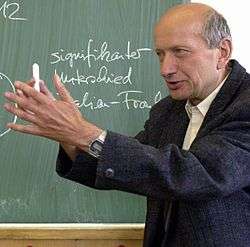Dietrich Stoyan

Dietrich Stoyan (born 1940, Germany) — mathematician, statistician; student of Mathematics at Technical University Dresden; applied research at Deutsches Brennstoffinstitut Freiberg, 1967 PhD, 1975 Habilitation. Since 1976 at TU Bergakademie Freiberg, Rektor of that university in 1991—1997; he became famous by his statistical research of the diffusion of euro coins in Germany and Europe after the introduction of the euro in 2002.
Research
Queueing Theory
Qualitative theory, in particular inequalities, for queueing systems and related stochastic models. The books
- D. Stoyan: Comparison Methods for Queues and other Stochastic Models. J. Wiley and Sons, Chichester, 1983 and
- A. Mueller and D. Stoyan: Comparison Methods for Stochastic Models and Risks, J. Wiley and Sons, Chichester, 2002
report on the results. The work goes back to 1969 when he discovered the monotonicity of the GI/G/1 waiting times with respect to the convex order.
Stochastic Geometry
Stereological formulae, applications for marked point process, development of stochastic models. Successful joint work with Joseph Mecke led to the first exact proof of the fundamental stereological formulae.
The book Stochastic Geometry and its Applications, by D. Stoyan, W.S. Kendall and J. Mecke reports on the results. The book of 1995 is the key reference for applied stochastic geometry.
Spatial Statistics
Statistical methods for point processes, random sets and many other random geometrical structures such as fibre processes. Results can be found in the 1995 book on stochastic geometry and in the book, Fractals, Random Shapes and Point Fields by D. and H. Stoyan. (J. Wiley and Sons, Chichester, 1994).
A particular strength of Stoyan are second-order methods.
At the moment Dietrich Stoyan is working (together with three colleagues) for a new book on point process statistics. He used packings of hard spheres as models for materials with the aim to solve mechanical problems for random heterogeneous materials.
Stoyan is very active in demonstrating non-mathematicians and non-statisticians the potential of statistical and stochastic geometrical methods. In particular, he coorganized together with Klaus Mecke conferences where physicists, geometers and statisticians met. See the books
- Mecke Klaus R. and Stoyan D. (eds.): Statistical Physics and Spatial Statistics. Lecture Notes in Physics 554, Springer-Verlag, 2000 and
- Mecke Klaus R. and Stoyan D. (eds.): Morphology of Condensed Matter. Lecture Notes in Physics 600, Springer-Verlag, 2002.
See also
External links
|